
John William "Blind" Boone (May 17, 1864 to October 4, 1927) | |
 Known Compositions Known Compositions | |
|
c.1880
The Marshfield Tornado1886
Cleo1891
Whippoorwill: Romance for Pianoforte1892
When I Meet Dat Coon To-NightWhar Shill We Go When de Great Day Comes 1893
Grand Valse de Concert, Opus 13Caprice de Concert, Number 1 Caprice de Concert, Number 2 Dinah's Barbecue You Can't Go to Gloria 1894
Melons Cool and GreenSparks That Little German Band 1899
Dat Mornin' in de Sky |
1902
Caprice de Concert, Number 3(Dance des Negres) 1907
Aurora Waltz1908
Geo'gia MelonBlind Boone's Ragtime Medley #1 "Strains from the Alleys" 1909
Blind Boone's Ragtime Medley #2"Strains from the Flat Branch" Last Dream: Waltzes c.1912
Gavotte ChromatiqueWoodland Murmurs 1913
Love FeastUnknown or Uncertain
Josephine PolkaThe Hummingbird |
 Selected Rollography Selected Rollography | |
|
Title
Gavotte ChromatiqueWoodland Murmurs Rag Medley No. 2 Camp Meeting Medley No. 1 Dixie (Dixie's Land) When You and I Were Young, Maggie Nearer My God to Thee |
Label
[QRS Autograph 80254][QRS Autograph 80268] [QRS Autograph 200142] [QRS Autograph 400034] [QRS Autograph 400038] [QRS Autograph 400044] [QRS Autograph 400048] |
The legendary ragtime pioneer John William Boone was born to Rachel Ann Carpenter Boone in 1864. Census records have indicated a range of birth years from 1862 to 1866, but 1864 appears to be the most accurate year of birth according to the author's research. Rachel was an escaped slave from Kentucky who found a position as a "contraband cook" for the Union Army in Miami near north-central Missouri. A mulatto, she claimed to be an indirect descendant of famed American Daniel Boone, a claim with some measure of credibility, and kept that name. John's father was a white bugler with the Union Army.
Given that information, the Union Army records show only one bugler in an applicable at that time period, Private William S. Belcher of Company F of the 3rd Regiment, Missouri State Militia Cavalry, then later with the 7th Regiment in the same capacity as bugler. Not only was he in the Miami area around the probable time of conception, but further investigation into Army records reveal that he was on a furlough to Miami about the time of John's birth in 1864. The furlough turned into an attempt to enlist with the 23rd Missouri Infantry the day after John's birth, which turned into a desertion charge from the Union Army and a conviction. After the war he married and became a farmer. It is unclear if he ever had more than peripheral contact with his son for whatever reasons.
Shortly after John's birth Rachel moved to Warrensburg, Missouri. She was shown there in 1870 working in washing and ironing, and was working for many prominent families in the area. Curiously, John, now called Willie, was shown as only four years old in that enumeration, and he had another brother, Wyatt H., father unknown, who was shown as two years old in 1870. On May 17, 1871, Rachel was married to widower James Harrison Hendricks in Warrensburg, Missouri, part way between Kansas City and Sedalia. In that moment, Willie gained another eight siblings from James' first marriage.
When Willie was around six months (some sources claim six years) old he contracted what the doctors called "brain fever," most likely some form of meningitis by later accounts,
and their cure was to have his eyes surgically removed to relieve the pressure, his lids sewn shut. Working through this supposed handicap, Willie made it into a gift. His skills in listening and recreating were clear when he was just a toddler. He could mimic bird calls and accurately drum out rhythmic patterns on tables or pans as a toddler. Having access to pianos around the neighborhood, Willie learned how to create melodies on them, and by age five had formed a small band with some of his friends. Supported by many residents of his neighborhood, they encouraged him to grow his talents.
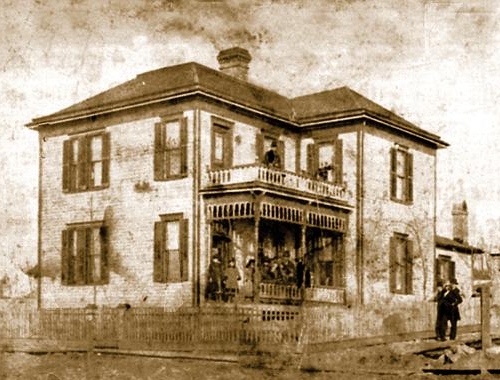 |
At age seven he received a French harp as a gift, quickly learning to tune and play it. This allowed him to earn some extra income, even before he was 8, playing it at various functions or in people's homes. When he was eight, Rachel ended her life as a single mother by marrying Harrison Hendrix, and eventually the couple added five more siblings to Willie's family. They moved to a one room cabin, but by all reports it was a loving household, and Willie remained close to his step-siblings throughout his life.
In an effort to accommodate her son's needs, Rachel enrolled Willie at the Missouri School for the Blind in St. Louis, with the generous help of donations by neighbors and townspeople, both black and white. Some also funded the train trip, and made him clothes to take along. His blindness and pure joy in life helped make all of them color blind as well. He left Warrensburg in the fall of 1873. It was clear early on that Willie was not happy at the school, and instead of communing with his own classmates, he preferred to listen to older students practice in the music room. One of them, Enoch Donley, befriended Willie and taught him basics of technique, and also introduced him to a piano teacher at the school. After a year of work, Boone was able to play virtually anything he heard with commendable technique.
The situation at the school changed within a couple of years, and a new supervisor was put in place, changing the way black students were treated. Willie was removed from most of his musical access and taught to make broom instead. In order to play he escaped the school at night (presumably with some assistance) and started hanging around the nearby tenderloin district where early forms of what would become ragtime were being performed. While he was able to pick up a lot from listening to the brothel and bar pianists, he was eventually caught enough times that he was expelled from the school. Forced to live on the streets, he played where he could, often in churches, and even sang to people in public places like train depots for money. Nearly starving, a conductor found him and managed to get him back to Warrensburg and his mother.
Back home, Willie continued to play in homes, halls and churches. It was in a church where he was giving a small concert that John Lange, a local contractor and successful black businessman, first heard Boone play. He was substantially impressed, and after some time decided to expand his scope of business operations, becoming one of the first African American managers of a concert artist. In preparation for sending Willie out into the world, Lange sent him to Christian College in Columbia for advanced musical training with Anna Heuerman. It was here that he learned a great love for classical music, which he was quickly able to emulate, and even duplicate, sometimes on the first or second hearing. After sufficient training, Boone came home, and with Lange formed the Blind Boone Company, adopting the motto Merit, Not Sympathy, Wins. Based in Columbia, the pair set out to make Boone famous, with resounding results - albeit slowly resounding.
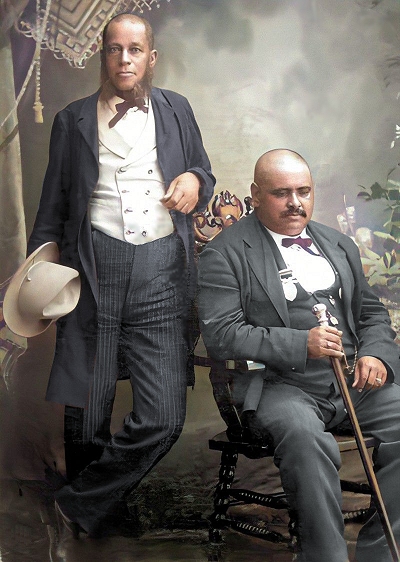 |
Boone's first official public performance under Lange's management was on January 18th, 1880 at St. Paul's Methodist Church in Jefferson City, the capitol of Missouri, when he was only fifteen and a half years old. Among the pieces he played there, and would continue to in future concerts, was Franz Liszt's Second Hungarian Rhapsody, Moonlight Sonata and other sonatas by Ludwig von Beethoven, and selections from famous operas. Later in the year he added his own Marshfield Tornado.
This was Boone's own pianistic representation of an F4 tornado that tore through Marshfield, Missouri on April 18, 1880, killing 99 people and injuring at least another 100. Descriptions of Boone's performance conjure up a tour de force of effects that potentially had a detrimental effect on the instrument, and it became his signature piece. Marshfield Tornado was never recorded or printed as Boone wanted it to be entirely his, each performance to be unique. In truth, it is questionable whether a player piano could have fared well with the onslaught of notes from Boone's hands. One newspaper described it as follows: The piece is a variation, beginning with the quiet of the Sabbath morning at church, the approaching storm and the roaring destruction as it sweeps over the town. The noise dies down and peace again reigns."
The early years of the show were difficult, but necessary to build Boone's reputation. Lange, Boone, and perhaps a couple of other, traveled the Midwest in a wagon carrying a piano with them, allowing them to set up wherever they needed and avoid the reservations some white piano owners might have about the boy's taking over of their instrument. However, this was hard on the instrument physically, and part of the budget from the income was set aside for replacement pianos every few months. As Boone's reputation grew, it seems that a good piano was more readily available at their destinations, and eventually they did not have to travel with one. They also often stayed with a local sponsor to avoid hotel expenses, but the home base was in Columbia.
In the June 5, 1880, enumeration taken in Warrensburg, Willie was shown as still residing in the Hendricks household, and was noted as blind. However, this may have been a placeholder to account for all family member, as three days later on Jun 8, Boone was shown as one of many boarders in the home of Columbia farmer Alfred Woods and his large family, although no profession is listed.
As Boone and Lange grew their show, Lange would hire somebody to set out a week or more ahead of the troupe for public relation purposes, advertising the coming of Boone with posters and word of mouth. Notices in the paper comparing Boone with the already established "Blind" Wiggins didn't hurt either, such as this one with an off-handed sleight towards the older artist from the Gettysburg Compiler of June 9, 1885: "Poor Blind Tom, the alleged[!] pianist, is discovering that another black pianist, known as Blind Boone, but who Tom considers anything but a boon to him, is about to become a formidable rival in concert business."
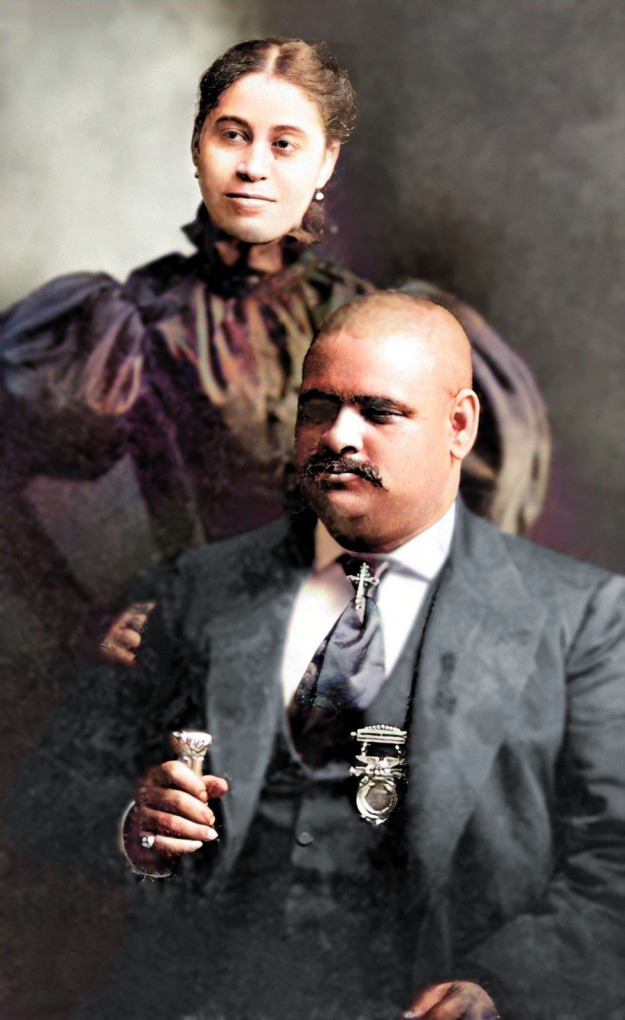 |
While Blind Tom had his own niche and a considerable lock on Midwest concert halls, the report was more or less predictive. By the end of five years, when Boone was approaching 21, the company had no problem getting booked in towns or cities of every size. The reviews were positive and more money was also coming in, so Boone and company were living well by the time the 1890s came around. In 1891, John married Eugenia Lange, his manager's youngest sister. They remained together for the rest of his life.
According to an article in a May 1893 edition of Kunkel's Musical Review, the Blind Boone Concert Company was in town for four weeks, and the star was greatly lauded. "His playing is remarkable, not because of his blindness, but because of his artistic excellence. John W. Boone is justly considered the successor of the celebrated [Louis Moreau] Gottschalk. He grasps with marvelous rapidity any composition played for him, and the most difficult pieces are played after single reading. His engagements here drew crowded houses nightly." The company also grew in size over the next decade, as Lange and Boone added vocalists to the show, including Emma Smith, Melissa Fuell, Marguerite Day, Stella May (just 16 when she was recruited) and Josephine Huggard. They also expanded their reach, performing at least 8,000 concerts in the United States between 1880 and 1895, along with performances in Canada, Mexico and Europe.
One of Boone's greatest joys was sharing his gifts and enthusiasm with children. He would openly promote his desire for parents to bring their children to his performances in order to bring them to music, and would sometimes bring large groups of them inside the performance hall for free, simply so he could encourage them to also learn the thrill of playing and sharing that gift. It evidently effected a great many youths who ended up working hard to learn to play, some actually becoming fine pianists in churches or theaters.
He often gave back to the church community that supported him, providing funds for a great many church and school building or repair projects wherever he went. According to the 1900 enumeration, Boone was firmly ensconced in Columbia, and Eugenia was now the treasurer for the company. His mother Rachel died in January 1901. Throughout his career Boone had composed a number of number of songs, instrumentals and classically styled pieces, many that were eventually published, including some notable ones between 1900 and 1910. This included the beautiful Aurora Waltz of 1907, reportedly inspired by descriptions of the aurora borealis over the northern hemisphere.
In 1908 and 1909 he contributed two medleys to the ragtime collective, largely made up of folk themes and some original derivatives. Blind Boone's Rag Medley Number One: "Strains from the Alleys", and Blind Boone's Rag Medley Number Two: "Strains from the Flat Branch", were not the same type of ragtime that many other composers had been writing by that time. They did represent, however, a more authentic look at the melodies and rhythms that would be the foundation of ragtime; a window into that time when Boone was a youth wandering through the St. Louis tenderloin hearing banjos and pianos pound out these tunes. He was listed in 1910 in Columbia as a traveling musician, but Eugenia did not have any vocation listed even though she was still active with the company, a common oversight of that time regarding women's roles in society.
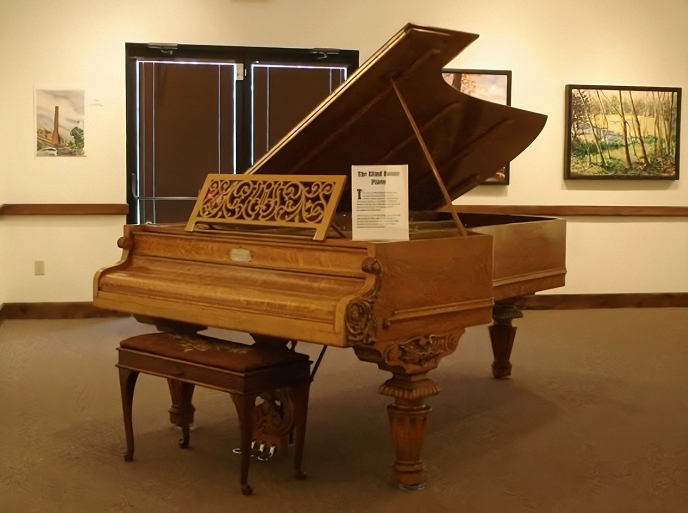 |
During his years as a prominent performer, his endorsement was sought out by certain piano companies, and in the end the Chickering Piano Company of Boston, Massachusetts, would offer him the biggest incentive of all. Chickering, perhaps Steinway's biggest U.S. rival at that time, offered him a large oak nine foot concert grand in 1891 which he enjoyed enormously. (It is now kept in the Boone County Historical Society in Columbia, Missouri, and can still be played.) They made several others for him over the years which he routinely wore out. However, his name did show up in connection with other instruments from time to time. Among those were Steinway and Estey, the latter being a famous organ builder as well. In The Music Trade Review of July 6, 1901, a letter of endorsement to Bush and Gerts was quoted: "The Bush & Gerts piano is a fine instrument, possessing a pure sweet tone, and any dealer may well be proud to handle such a piano. It is bound to make friends wherever it is known and sold." One month later on August 3, 1901, the following was printed in the MTR:
Carl Hoffmann, of Kansas City, Mo., is, and long has been, a Chickering enthusiast. The new model Chickering baby grand which he received last week, has, however, compelled more than the ordinary number of adjectives to express his approbation of its musical merits.
While testing this instrument, "Blind" Boone, a negro musician widely known throughout that section, strolled in and became so enamored with the Chickering grand that he purchased it, notwithstanding the fact that he already has several Chickering pianos in his possession. He knows a "good thing" without seeing it. It is said there are few better judges of tone than "Blind" Boone, and it does his judgment credit when he selects a Chickering.
In the case of many concert pianists, the highly-regarded Boone in particular, it seems that any company that could encourage him to wax poetic on their instrument would exploit those words in their favor, in spite of his association with other companies. Another example is found in the May 28, 1910 MTR concerning the R.A. Rodesch player piano: "Blind Boone, who is one of the celebrated pianists of the West, visited our factory just before [President R.A. Rodesch] left and he was so delighted with what he saw and heard that he left an order for one of the players to be installed in his own piano." Yet another Chickering endorsement was printed on October 9, 1915, and it outlines some of his technique for learning new pieces:
BLIND PIANIST USES THE PLAYER.
Blind Boone, About to Go on Annual Concert Tour, Studies by Means of Knabe-Angelus
— Uses the Chickering Grand for Concerts
— Pianist Well Known in the West.
Blind Boone, About to Go on Annual Concert Tour, Studies by Means of Knabe-Angelus
— Uses the Chickering Grand for Concerts
— Pianist Well Known in the West.
KANSAS CITY, MO., October 5. — Blind Boone is starting early in October on his annual tour. Boone is hale and hearty, with all his old fire. It is a constant regret to him that there is not a Chickering piano in every hall where he plays. He has a large Chickering grand in his own home and there is a smaller 'Chickering in the home of his manager, John Lange, 912 Park avenue, Kansas City. Boone learns all his compositions now from an Angelus player built into a Knabe piano to his order. The player renders two or three pages at a time, which are then played by Boone on his Chickering; then the player renders two or three more, and so on. Boone commits ten or twelve pages a day. He is, of course, an inveterate purchaser of rolls, learning all the latest productions, but is very partial to the compositions of the masters. He had an extra stop put in his player so that he could interrupt in the middle of a measure.
One of Boone's last endorsements was found in the February 1, 1919 MTR:
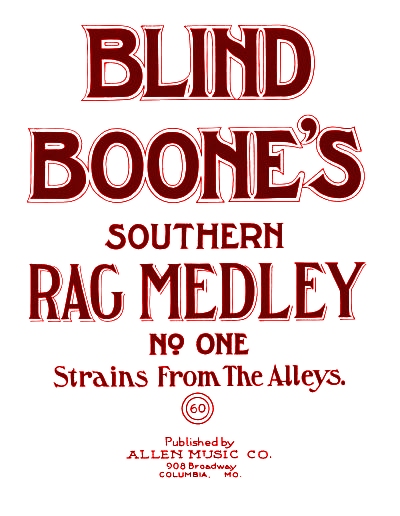
"Blind Boone," Musical Genius, Pays High Tribute to [Kohler & Campbell] Instrument at Recital
One of the most interesting comments received on the merits of the Kohler & Campbell piano was contained in a short address which was recently given in the Sonora music rooms, Mount Vernon, 111., by "Blind Boone," who, having lost his sight from brain fever when only six months old, has always displayed remarkable genius for musical talent. He also has marvelous ability in reproducing any selection once heard on the piano, remembers a voice once it is heard and delights in recalling a handshake.
While at the Sonora music rooms he was furnished, at the request of the Plaza Theatre of that city, with a Kohler & Campbell piano, Style 8, to be used in conjunction with his program, before commencing which he paid the following tribute to the instrument:
"I want to thank Mr. Stephenson for the splendid piano which he has so kindly furnished me with that I might be able to render this program. It is one of a rare make, has a beautiful tone, and it has a splendid action. You will find the Kohler & Campbell a remarkable instrument for the price, the base is excellent and any piano that stands my 'Marshfield Storm' is a good one."
Boone entered his fourth decade of concertizing in 1910. In late 1912 John recorded Rag Medley Number Two and six other tunes from his repertoire to piano rolls for the QRS Piano Roll Company on their Autograph series, one of the first black artists to do so. It is said (hard to verify) that on his recording of When You and I Were Young Maggie that he actually jammed or overloaded the recording mechanism because of the number of notes he was playing in rapid succession at great velocity. One of his favorite concert segments was asking somebody from the audience to play a piece he didn't know (and that was a limited list), after which he would sit down and play it back for them, something that impressed even the highest ranking musicians.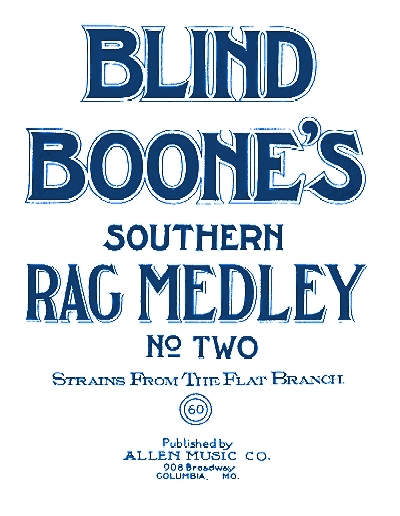 It was clear that not only could play virtually anything in the classical style, but that he could also make it his own, infusing Afro-American rhythms and other tricks into the performances. While he didn't quite "rag" the pieces, he did give them a kick that most performers at that time were perhaps not as adept as executing.
It was clear that not only could play virtually anything in the classical style, but that he could also make it his own, infusing Afro-American rhythms and other tricks into the performances. While he didn't quite "rag" the pieces, he did give them a kick that most performers at that time were perhaps not as adept as executing.
 It was clear that not only could play virtually anything in the classical style, but that he could also make it his own, infusing Afro-American rhythms and other tricks into the performances. While he didn't quite "rag" the pieces, he did give them a kick that most performers at that time were perhaps not as adept as executing.
It was clear that not only could play virtually anything in the classical style, but that he could also make it his own, infusing Afro-American rhythms and other tricks into the performances. While he didn't quite "rag" the pieces, he did give them a kick that most performers at that time were perhaps not as adept as executing.By 1916 it was estimated that the Boone Company had played over 26,000 concerts in 36 years, suggesting many days where three or four performances were held. But that was perhaps the peak of his career, and his long-time friend and manager John Lange died that same year. The novelty had started to wear off, particularly with a world that was progressing ahead, a world that was at war, and a world that was looking for change. While vaudeville was still thriving in 1920, the beginning of the "jazz age," and movies were coming into their own, Boone's act was old hat by now. Without Lange the bookings diminished greatly and Boone, once flush with money, found himself and Eugenia struggling to make ends meet.
In 1920 John and Eugenia are listed in Columbia with her as the head of household, and neither with an occupation listed. He continued to play sporadically over the next several years, but started to show signs of physical deterioration and other health issues. Yet the positive reviews kept appearing. One from September 8, 1924, from the Cape Girardeau Southeast Missourian stated that "Boone proved himself an artist of great versatility playing classical music with the grace and feeling of a true artist, interpreting folklore selections, and singing them with great drollness, and whipping off ragtime selections with as much energy as would Paul Whiteman's best 'tickler over the ivories.'" In December 1925, the same paper reported Boone off on another seven month tour to "Illinois, Kansas, Oklahoma, Colorado, New Mexico and California.
The end was become inevitable, however. His final public concert was held on May 31, 1927 in Virden, Illinois, during which he announced his plans to retire. Boone's statement found its way into the papers in short order, as partially quoted here:
Blind Boone, negro pianist... brought his colorful concert career of 47 years to a close recently...
After completing a program before a large crowd, the aged musician announced the concert was his final appearance on tour and perhaps his final appearance for all time.
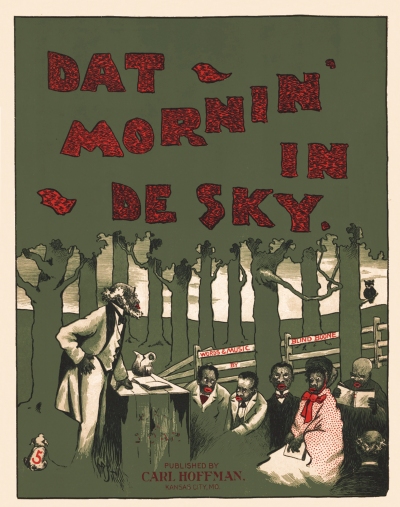
He will retire to Columbia, Mo., this summer and to recover his failing health. It is probable he will give further concerts on special occasions. Columbia was also the home of John [Lange], who for 36 years was Boone's manager. [Lange's] death is believed to have had a telling effect on Boone.
In his last concert he was assisted by his niece, Miss Margaret Day, who sang many of his compositions, including "Keep On Till the Judgement." He also played his famous "Marshfield Tornado."...
Blind Boone played many concerts in Kansas City, many of them in churches. Years ago one of his regular appearances here was at the old Lydia Avenue Christian church, Fifteenth st. and Lydia av. Always he impressed his audiences with his compositions, his technique, his remarkable memory and a huge watch...
[He] would have a "children's program," producing his huge watch. Asked what time it was, he would press a stem and the watch would chime the quarter, half and full hours, to the delight of his juvenile auditors.
It was [in Springfield, Illinois] in September, 1909, Boone first met Bert Williams, comedian. The musician called on the singer at the Shubert theater. Williams' dressing room is closed to many of his race, but he welcomed Blind Boone. Complements were mutual...
"I feel fully repaid for my so-called affliction," Boone says. "I have music, friends, and am happy."
Boone is a business man as well as a musician. His investments have been good. It is estimated his average annual income is about $17,000.
Another report the following week in The Afro American claimed he has earned some $350,000 during his career claiming he was worth that much, not accounting for the expenses of travel and life in general along the way. Even with such a high income his growing expenses and payment of debts kept the family from being flush. John W. Boone was felled by a fatal stroke and acute dilation of his heart while visiting his half-brother Harry in Warrensburg in October, 1927. In spite of the grand reports of his impressive income, Boone's estate was worth a mere $132.65. Eugenia was soon reportedly found to be insane, although any record of commitment is difficult to locate. There was not even enough money left to afford a proper marker for John's grave.
Fortunately the people of Columbia have since successfully resurrected the memory of Boone, forming the Blind Boone Memorial Foundation, Inc. in 1961. The Chickering oak grand was restored for a concert that same year by the Joplin Piano Company, and the first memorial concert was held using that instrument. They were responsible for marking his grave in 1971, and opening a museum dedicated to him and Missouri folk music. There is an annual ragtime festival held each June in Columbia, Missouri, named in Boones honor, in the grand Missouri theater. His last words speak well of his mission in life, which was most certainly accomplished wherever he went. "Blindness has not affected my disposition. Many times I regard it as a blessing, for had I not been blind, I would not have given the inspiration to the world that I have. I have shown that no matter how a person is afflicted, there is something that he can do that is worthwhile." He proved this beyond the shadow of any doubt, opening doors for a number of African-American artists and businessman through his generosity and extraordinary talent.
A great deal of this biography was extracted or assembled from public government records, school records, newspapers, periodicals and commonly known information about Boone. Some of the information was culled from Blind Boone: Missouri's Ragtime Pioneer by Jack A. Batterson with Rebecca B. Schroeder, available from many sellers including Amazon.com. Thanks also to the Blind Boone Ragtime Festival and Blind Boone Park in Warrensburg, Missouri, for their continuing efforts to keep Boone's memory and positive message of hope alive.